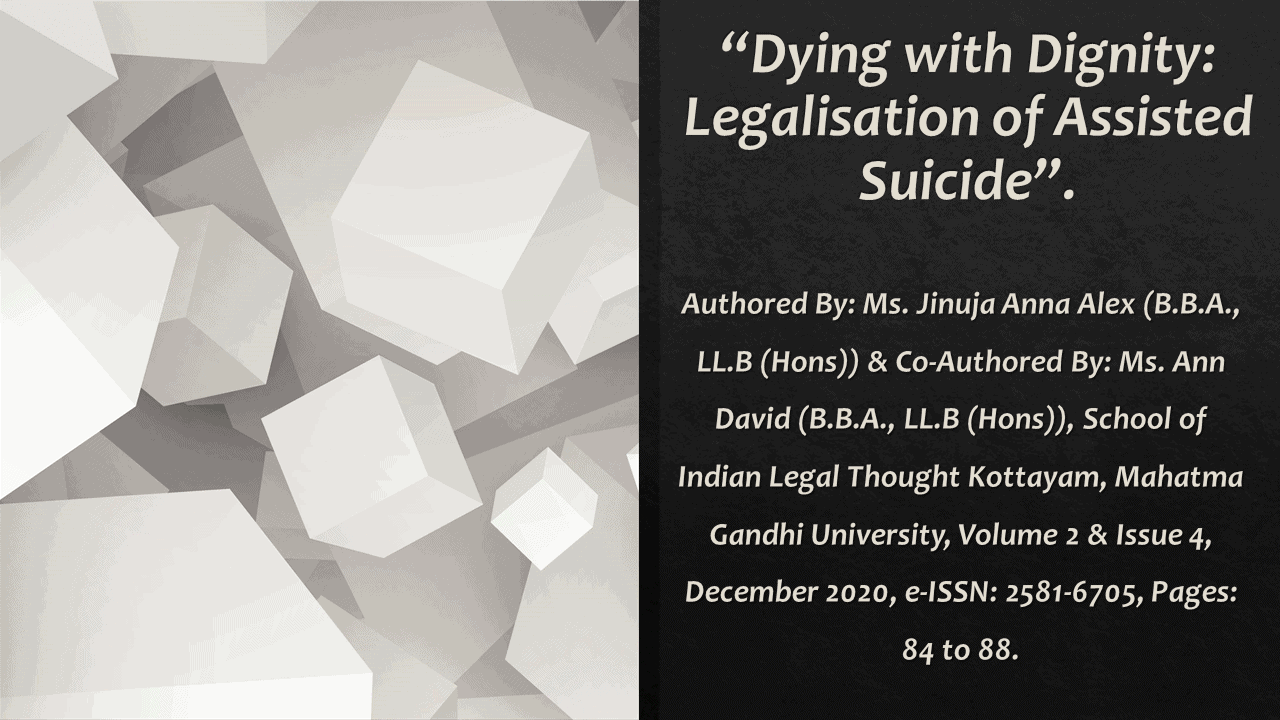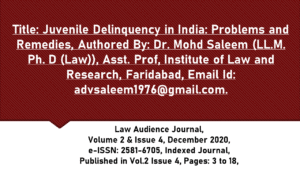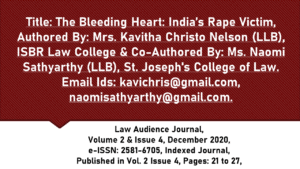Click here to download the full paper (PDF)
Authored By: Ms. Jinuja Anna Alex (B.B.A., LL.B (Hons)) & Co-Authored By: Ms. Ann David (B.B.A., LL.B (Hons)), School of Indian Legal Thought Kottayam, Mahatma Gandhi University.
Click here for Copyright Policy.
Click here for Disclaimer.
“Dying with Dignity: Legalisation of Assisted Suicide”
Imagine the life of a person who is already housebound and is dependent on others for each and everything, a person who is suffering from intolerable pain for a long period of time-how can he himself or his family members bear the pain of him being through such a pathetic state. Whether the person should be allowed to die or be in continued agony? Should a doctor be freed from the legal barriers to help that person to end his life or prescribe some fatal pills so that he/she can end his/her life himself/herself? Or should a doctor be forbidden by law to assist the suicide of any person who suffers from a terminally ill or debilitating disease? These questions lead to another question, Why Not Legalise Assisted Suicide? There may be practical difficulties in legalizing it as it involves the question with regard to the life of a person (right to life), but right to live would, however, mean right to live with human dignity up to the end of natural life. The right to live would include the right to die with dignity at the end of life and here comes to light the question of legalization of assisted suicide.
Assisted Suicide is defined as suicide committed by someone with the assistance of another person, especially Physician Assisted Suicide (PAS).[1] PAS is a hybrid between passive and active euthanasia, where a physician supplies information or the means of committing suicide to a person, so that, the individual can successfully terminate his/her life. It’s a form of voluntary euthanasia i.e., it involves a patient voluntarily acting to end his/her own life. Currently, PAS is legalized in parts of Australia, Belgium, Canada, Luxembourg, The Netherlands, Switzerland, and several US States.[2] In India assisted suicide is illegal. Only passive euthanasia is legal (Aruna Ramachandra Shanbaug v. Union of India)[3] which involves withdrawal of treatment or the administering of high doses of pain-relieving drugs which has side effects that fasten death. One of the important questions that need to be analysed while dealing with the matter of legalization of assisted suicide is whether right to life under Article 21 of the Indian Constitution includes within its purview, ‘The Right to Die’? The Supreme Court has dealt with this question considerable times and has acknowledged different opinions. In State of Maharashtra v. Maruti Shripati Dubal[4], the court observed that the right to life under Art. 21 of the Constitution could also be interpreted as the right not to live a forced life. In P. Rathinan v. UOl[5], the supreme court upheld the view in State of Maharashtra v. Maruti Shripati Dubal[6]. In Gian Kaur v. State of Punjab[7], It was settled that the right to life under Art. 21 does not include the right to die. It was observed that Art. 21 is a provision guaranteeing protection of life and personal liberty and by no stretch of imagination can extinction of life be read to it.
This was the view of the court with regard to the inclusion of the right to die within the purview of Article 21. But, in 2015, in the case of Aruna Ramachandra Shanbaug v. Union of India[8], the Supreme Court of India held that passive euthanasia could be given a nod in case of exceptional circumstances under strict monitoring of the apex court, recognizing living will the Supreme Court pointed out that the right to die with dignity is a fundamental right. In another case Common Cause v. Union of India[9], the court held that passive euthanasia and a living will are legally valid and also, the court issued detailed guidelines in this regard.
The recognition of “living will” does pave a way for the legalisation of assisted suicide but the problem lies in the existence of the penal provisions, section 306 IPC and section 309 IPC for attempt of suicide and abetment of suicide respectively. To begin with the penal provisions, suicide is not an offence in India but attempted suicide is under section 309 IPC. Abetting (assisting) suicide in an offence under section 306 IPC. So is abetting attempted suicide by virtue of section 309 read with 107 of IPC. Several challenges were made before the Supreme Court challenging the validity of offence of abetting suicide under section 309 IPC. The case of Maruti Shripati Dubal v. State of Maharashtra[10], brought into light the issue of constitutional validity of section 309 IPC and the court held that every fundamental right has both positive and negative aspects. The negative aspect of article 21 proclaims right to die, and hence section 309 IPC violates article 21 of the Constitution. Again, in P. Rathinam and Nagabhushan Patnaik v. Union of India[11], the apex court held that section 309 IPC violated article 21 and court added that the section was cruel, irrational provision that needs to be effaced from statute books to humanize penal laws and as the Act is not against any religion, morality and public policy with no beneficence to society the state intervention on personal liberty is uncalled for.
Hence, section 309 IPC was not held in line with article 21 of the Constitution. After this decision in Gian Kaur v. State of Punjab[12], the court observed that right to die with dignity at the end of natural life should not be confused with the right to die an unnatural death curtailing the natural span of life. Suicide is unnatural extinction of life; natural positive right cannot go with natural negative right. Hence, constitutional validity of section 309 was upheld and it does not violate article 21 of the constitution.
Additionally, in support of this offence in Gian Kaur v. State of Punjab[13], the SC observed that, the arguments which are advanced to support the plea for not punishing the person who attempts to commit suicide do not avail for the benefit of another person assisting in the commission of suicide as in its attempt. The abettor is viewed differently, in as much as he abets the extinguishment of life of another person, and punishment of abetment is considered necessary to prevent abuse of the absence of such a penal provision. This is what is applicable in case of assisted suicide.
So, initially, the court was of the opinion that section 309 was unconstitutional as it was violative of article 21 but gradually that view of the court changed. But it is somehow not acceptable that a provision which allows a person who is fed up with his life, one who has attempted to commit suicide survives burdens him with criminal liability-how can this be rationally reasoned conclusion. Also, what role does the law give to the deceased’s consent in such cases? The examination of sections 306 IPC and section 309 IPC makes it crystal clear that, people who assist another to commit or attempt to commit suicide or who perform the act of active euthanasia criminally responsible. The consent of the deceased to be killed, even if informed and freely given is of no avail, at most, success to reduce the change or the punishment but does not exculpate the accused altogether. The decriminalisation of these sections will make the legalisation a lot more trouble free.
Legalisation would require a perfect statute that covers all the loopholes providing misuse. Several countries have passed the Death with Dignity Act. Death with Dignity Act stems from one basic idea-terminally ill people have the right to end their lives on their terms. Death with Dignity statutes allow mentally competent adult state residents who have a terminal illness with a prognosis of having six or fewer months to live to voluntarily, request and receive a prescription medication to hasten their inevitable, imminent death. By adding a voluntary option to the continuum of end-to-lifecare, these laws give patients dignity, control and peace during their final days with family and loved ones.
A perfect model that India could adopt to draft a legislation permitting assisted suicide is The Oregon’s Death with Dignity Act, which is widely acclaimed as a successful and which studies have proven to have safeguards to protect patients and prevent misuse. Oregon became the first jurisdiction in the USA to enact a law authorising PAS by enacting Oregon Death with Dignity Act, 1994. The Act provides stringent provisions to prevent misuse. For a person to be eligible to receive prescription drugs for use in PAS, one must be 18 years of age and have been diagnosed by a physician with an incurable and irreversible disease which will cause the death within six months. The patient must have made both an oral and written request and have repeated the oral request to the attending physician not less than 15 days after making the first oral request. The Act requires for medication to be in a prescribed form signed and dated by the patient and witnessed by at least two people who attest in the patient’s presence that to the best of their knowledge and belief the patient is capable, acting voluntarily and is not being coerced to sign the request. Additionally, at least one of the witnesses must not be related to the patient or entitled to a benefit from the patient’s estate, or be an owner, operator or employee of a healthcare facility where the patient is receiving treatment or is a resident.
It is a universal truth that a person who is born will definitely die one day. So, it is basically meaningless to raise oppositions like chances of abusing assisted suicide if it is legalised as every right involves the risk of being abused. We should always look at the brighter side of its legalisation- the fact that how many people would be relieved from the agony of terminally ill disease, to help the people who are waiting for death each day. Even though this is a debatable topic the chances of the legalisation of assisted suicide is not so outreaching as passive euthanasia has been legalised and living will have been recognised (Aruna Shanbaug and Common Cause Case)[14].
Apart from this, there is Medical Treatment to Terminally ILL Patients (Protection of Patients and Medical Practitioners) Bill, 2006, which is a Bill to provide for the protection of patients and medical practitioners from the liability in the context of withholding or withdrawing medical treatment including life support system from patients who are terminally ill. All these provide a light of hope towards recognising the right of a man to die with dignity.
[1] Assisted suicide, MERRIAM- WEBSTER, https://www.merriam-webster.com/dictionar/assistedsuicide.
[2] https://www.mydeath-mydecision.org.uk/info/assisted-dying-in-other-countries/.
[3] (2011) 4 SCC 454.
[4] (1986) 88 BOMLR 589.
[5] AIR 1994 SC 1844.
[6] 1987 (1) BomCR 499, (1986) 88 BOMLR 589.
[7] 1996 AIR 946.
[8] (2011) 4 SCC 454.
[9] Writ Petition No. 215 of 2005.
[10] 1987 (1) BomCR 499, (1986) 88 BOMLR 589.
[11] AIR 1994 SC 1844.
[12] 1996 AIR 946.
[13] Ibid.
[14] (2011) 4 SCC 454.



